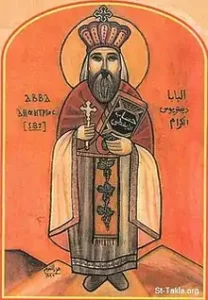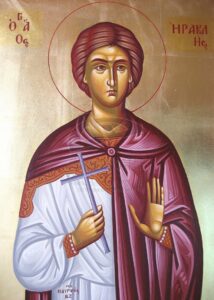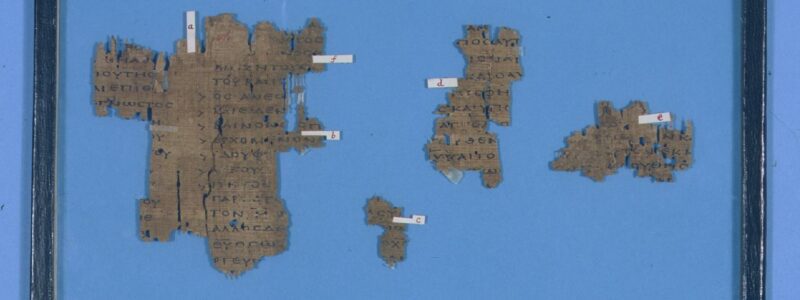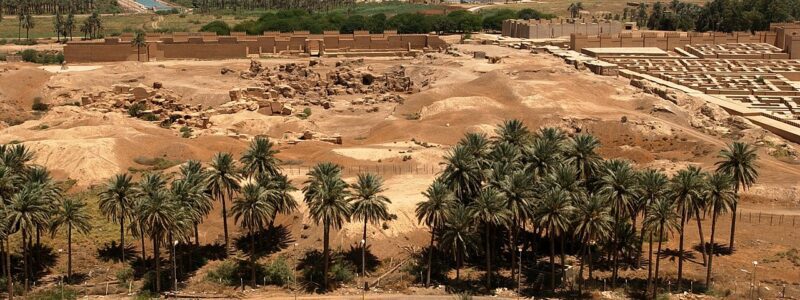Apostle Peter and First New Testament
The students of the Apostle Peter confirmed the accuracy of the first New Testament, similar to those of Paul and John.
Peter may be the oldest of the original disciples of Christ. He is also known as Simon Cephas from the Aramaic version of his name. Peter and his brother Andrew were fishermen and were about their vocation when they first met Jesus. Peter was a fisherman and likely illiterate with little, if any, formal education and likely illiterate.
Mark became very close to Peter, so much so that Peter called him “my son.” (1 Peter 12:12-16). The early church believed that Mark’s gospel was the eyewitness account of Peter. Papias, one of the ancient Church fathers who lived from 60 – 130 AD) and served as Bishop of Hierapolis (now located in western Turkey), claimed that Mark wrote his gospel as dictated by Peter. He reported,
Mark, having become the interpreter of Peter, wrote down accurately though not indeed in order, whatsoever he remembered of the things said or done by Christ.
Irenaeus repeats this historical fact that Mark’s gospel reflects Peter’s words (a student of Polycarp who was himself a student of John), wrote,
Mark, the disciple, and interpreter of Peter, did also hand down to us in writing what had been preached by Peter.
The Church in Alexandria, founded by Mark, had a long and unbroken chain of Patriarchs until the Council of Nicea in 325 AD. The oldest New Testament was written at about this time, now known as the Codex Sinaiticus. The Alexandrian Church Patriarchs date back to Mark the Evangelist. These Patriarchs quoted liberally from the books of the New Testament and were thereby confirming these writings as being historical and accurate.
Furthermore, the separate churches throughout Christianity (including those with roots in John and Paul) all used these same writings that eventually became formalized in the New Testament.
Mark, Peter, and the Early Church
The ancient historian Eusebius of Caesarea, Herod Agrippa, during the first year of his reign over Judea (AD 41), killed James, son of Zebedee, and arrested Peter, planning to kill him after the Passover. Peter was miraculously rescued by angels who got him out of jail.
After his rescue, Peter fled to the household of Mark’s mother. A prayer gathering of many Christians was held there to pray for the release of Peter from prison (Acts 12:12). The family was wealthy as they had a maidservant (Rhoda), and a big enough house to hold large worship meetings.
Peter then escaped the territory of Herod Agrippa and went to Antioch. He then went through Asia Minor ( Peter 1:1) and finally went to Rome during the second year of the reign of Claudius (AD 42).
Sometime during all these travels, Peter met Mark and took him on his travels as a companion and interpreter. Mark then wrote down the sermons of Peter, composing the Gospel of Mark.
According to tradition, Mark went to Alexandria in Egypt in 49 AD and founded the Church of Alexandria. The Coptic Orthodox Church, the Greek Orthodox Church of Alexandria, and the Coptic Catholic Church now represent this original church.
Mark became the first bishop of Alexandria and is honored as the father of Christianity in Africa.
Mark was succeeded by Anianus during the eighth year of Nero (62/63), probably due to his coming death. The idolaters of the city resented Mark’s efforts to turn citizens away from worshipping their traditional gods to Christianity. In 68 AD, they placed a rope around his neck and dragged him throughout the city until dead.
Anianus
The association between Mark and Anianus is an interesting one. Mark was returning to Alexandria in Egypt when his sandal fell apart. He found a cobbler, Anianus, who was able to repair it. During this repair, Anianus hurt his hand, piercing it with an awl. Mark took this opportunity to miraculously heal his hand while explaining the gospel of Christianity to him.
Anianus was very grateful to Mark and invited Mark to his home. Mark converted Anianus and his entire family to Christianity, and they were all baptized.
At the same time, many citizens heard about the miraculous healing of the injured hand of Anianus’ and converted to Christianity. This caused many of the pagans in the city to feel obligated to defend their gods against this new religion being introduced into the area.
Mark realized the antagonism of many of the Alexandrian citizens against him and decided it would be best if he left the city for a while. He ordained Anianus a bishop in his absence while ordaining others to the ministry.
Mark ended up being absent from Alexandria for about two years. When he returned, he found the church in Alexandria had grown considerably under the leadership of Anianus.
Mark was correct in assessing the temperament of the citizens of Alexandria against him as he was soon martyred. Anianus then became the patriarch of the church in Alexandria. He would lead the church for about seventeen and one-half years, during which time the church grew significantly.
Anianus died in bed and was buried next to Mark at a church.
Avilius
Avilius was unanimously elected as the leader of the Alexandrian church after the death of Anianus in 83 AD during the reign of the Roman Emperor Domitian.
Avilius was known for his chastity and caring for the people of Christ. He grew the church in Alexandria, greater Egypt, and Sudan. His time as leader of the Alexandrian church was peaceful.
Kedron
Priests and bishops conferred with the Christian people to determine who should lead the church in Alexandria after Avilius died. They elected Kedron as the next Patriarch in 96 AD.
Kedron was arrested and martyred in the persecution of Emperor Trajan. The reason for his arrest was that one of the Roman governors asked him, “Why do you not have our gods partake with your God and continue to worship him?” Kedron answered, “Because we do not prostrate before any others. His martyrdom occurred in 106 AD.
Kedron was known for his chastity and caring for the Christian population.
Primus
Primus was noted to be ascetic and pious and did many good deeds. He was appointed Patriarch in 106 AD after the death of Kedron. The church was in peace and tranquility during his reign.
Justus
Justus was baptized by Mark, along with many of his family. Mark appointed him as the first Dean of the Catechetical School of Alexandria. He was ordained a deacon by Anianus and then a priest. He was eventually chosen as Patriarch to lead the church in Alexandria.
He died in 129 AD and is buried with Mark and the other Patriarchs.
Eumenes of Alexandria
Eumenes was the second Death of the Catechetical School of Alexandria after Justus. During his time as Patriarch, he ordained several bishops and sent them into the greater area, including Egypt, Nubia, and Pentapolis, to spread the good news.
The persecution of Christians increased during his reign, with many of his congregations being martyred. He died in 141 AD after leading the church for thirteen years.
Markianos of Alexandria
He was born in Alexandria and became the Dean of the Catechetical School of Alexandria before being appointed Patriarch in 141 AD. He died in 152 AD.
Celadion of Alexandria
Celadion was born in Alexandria and was much loved by his people as righteous and wise. He was elected Patriarch in 152 AD.
The church was peaceful during his leadership, with nothing troubling the serenity of the Christians.
He died in 166 AD during the reign of Marcus Aurelius.
Agrippinus of Alexandria
Upon the death of Celadion, Aggripinus was chosen Patriarch by the people and clergy. His time as a Patriarch was peaceful during his reign of twelve years.
He died in 178 AD.
Julian of Alexandria;
Julian was known for being wise, studying the Bible, and “walking in the path of chastity and religion and tranquility.”
A synod of bishops and the laity appointed him Patriarch in 178 AD.
He did not stay in Alexandria but traveled throughout North Africa, ordaining priests everywhere, trying to emulate Mark.
Demetrius of Alexandria

Demetrius of Alexandria
We know a lot more about Demetrius for several reasons. He had one of the longest reigns of any Patriarch, governing for forty-two years and living until age 105. He was also intimately associated with Origen, one of the more colorful writers of ancient times.
He started as a farmer living with his wife for many years. The ailing Patriarch Julian had a vision informing him that his successor would visit him with a cluster of grapes that were out of season at the time. The reason for his visit was to ask for the Patriarch’s blessings.
The next day, Demetrius visited him with a cluster of grapes and was announced next as the church Patriarch after Julian’s death.
Demetrius was interested in establishing fixed dates for church feasts and fast days. He established this calendar but found himself embroiled in the Easter controversy. He applied the calculation method for determining the dates for Easter, and his edit was eventually approved by the Nicene Council (325 AD).
Demetrius supported Origin at the beginning of his career, admiring his scholarship. Their friendship was shattered when Origin fled Alexandria when the city was destroyed by Caracella – one of the most evil of the Roman Emperors. Origen fled to Caesarea, and the Palestinean bishops requested him to give sermons. However, he was not ordained and was not supposed to teach the laity through sermons.
Many have concluded that Demetrius’ treatment of Origin was mostly out of jealousy.
Heraclas of Alexandria

Heraclas of Alexandria
Heraclas was born to pagan parents who converted to Christianity after Heraclas’ birth. Demetrius ordained him into the clergy. He was very successful in his ministry and rose to the ecclesiastical hierarchy.
He followed Origin as head of the Catechetical School of Alexandria. When Demetrius died, Heraclas was chosen Patriarch, with his reign lasting about sixteen years until his death.
Dionysius of Alexandria (Dionysius the Great)
Much of what is known about Dionysius is from his letters and other correspondence. While only one original letter exists today, Eusebius has excepted many of the others.
He was born to a wealthy pagan family and spent most of his early life reading the works of polytheists. He converted to Christianity when he received a vision from God. He was commanded to vigorously study the heresies affecting the Church so he could address and refute them through doctrinal study.
He was a student of Origen and Heraclas. There was major persecution of the church in Alexandria in 249 AD, where hundreds were killed as they refused to deny their faith in Christi. Dionysius managed to survive this persecution and the civil war that followed.
Things got even worse when the Roman Emperor Decius issued a decree of legal persecution. Many Christians denied their faith, while others were persecuted, tortured, and executed. Others fled into the desert, where they often perished due to the harsh conditions.
Right out of a modern spy model, Dionysius was pursued by a Roman assassin to kill him on sight. He escaped his professional assassin by moving to the Libyan desert until the end of the persecution the next year.
The Roman Emperor Valerian then took over the empire and imprisoned and then exiled Dionysius. The next emperor reversed Valerian’s decree, released Christians from prison, and brought back those in exile, including Dionysius.
Dionysius died in 264 AD after leading the African church for 16 years.
Maximus of Alexandria
The reign of Maximum was peaceful, with no interference from the Romans. He ruled the church for about 18 years until 282 AD.
Theonas of Alexandria
Theonas was noted to be a Christian scholar who expanded the Alexandrian church by converting many unbelievers to Christ. He also fought against heresies creeping into the church. A man named Sabellius taught that the Father, Son, and Holy Spirit are all one person. Theonas excommunicated him and wrote to invalidate this heresy.
Theonas’ reign would end with his death in 300 AD.
Peter of Alexandria
History states that Peter was given by his parents to Theonas to be brought up Christian and hopefully enter the clergy. He rose through the ranks, becoming a reader, a deacon, and a priest.
Theonas advised church leaders to choose Peter as his successor while on his deathbed, which they did. Peter’s time as Patriarch included the Diocletian Persecution, which started in 303 AD and continued intermittently for the next ten years.
Many Christians were arrested, jailed, tortured, and killed during this persecution. Peter would not escape being killed during this persecution.
The Patriarch was seized and thrown into prison. The Emperor ordered him to be beheaded, but this was hindered by a large group of Christians who congregated at the prison, willing to die for the Patriarch. Not willing for the people to be slaughtered, the Patriarch schemed with his guards to sneak him out of a hold in the prison wall and then execute him outside the prison in a private manner.
One ancient writer describes the martyrdom of the Patriarch,
And he took off his omophorion, and bared his neck, which was pure before the Lord, and said to them: «Do as you have been commanded». But the soldiers feared that trouble would befall them because of him. So they looked one at another, and not one of them dared to cut off his head, because of the dread which had fallen upon them. Then they took counsel together and said: «To him that cuts off his head each one of us will give five denarii». Now they were six persons; and one of them had some money; so he took out five and twenty denarii from among the coins and said : «He that will go up to him, and cut off his head, shall receive this money from me and from the four others». So one of the men went forward, and summoned up his courage, and cut off the head of the holy martyr and patriarch Peter; that day being the 29th of Hatur.
He died in the year 311 AD.
Achillas of Alexandria
Achillas was born in Alexandria and was known for his piety and knowledge. He was an expert in Greek philosophy and theological science.
Peter recommended he be succeeded by Achillas in 312, shortly after Peter’s martyrdom. Arius died only six months after his installation, dying in 313 AD.
Alexander of Alexandria
He became Patriarch upon the death of Achillas. He faced multiple challenges during his reign,. One of these challenges was a schismatic sect that disputed the timing of Easter. Alexander defended the conventional dating of Easter by writing a special treatise in which he cited earlier statements by Dionysius.
The second controversy was with Meletius of Lycopolis. Meletius established a schismatic church separate from the main body of Christians ruled by Alexander. He even consecrated bishops without his superior’s consent. This controversy would eventually be settled at the Council of Nicea, where Alexander allowed Meletius to return to the church, effectively ending the controversy.
Arianism would be the third and perhaps most difficult challenge. Arius had achieved great influence on the Christian community in Alexandria. The controversy started when Alexander declared the unity of the Trinity in one of his sermons. Arius responded by labeling Alexander’s state Sabellianism which had already been rejected, as a heresy at this time.
Arius contended that Christ is the Son of God who was begotten by the Father, with the difference being that the Son of God did not always exist. Instead, Christ was “made” before “time” by God the Father. Therefore, Christ was not coeternal with the Father and was “God” only in name. Christ is subordinate to the Father as he is “begotten” by God.
The Council of Nicea of 325 AD declared Arianism to be a heresy. However, Arianism persisted for many years.
Alexander died only a few months after the Nicene Council developed the Nicene Creed, which is now recited in most Christian Churches today.
Even though Arianism was declared a heresy at the Council of Nicea, it has persisted through the centuries. Arian theology is promulgated today in only a few church groups whose view of the Trinity distinctly differs from more orthodox groups.
Summary
The New Testament was formalized in the earliest New Testament, written at about the same time as the Nicene Council in 325 (or slightly later). The writings of an unbroken line of Patriarchs of the Alexandrian Church dating from the time of Mark the Evangelist confirm the historicity and authenticity of these works.
Furthermore, even though the churches established by Paul and John were separate geographically from the church in Alexandria, Egypt, they all quoted from the same sources. These sources include most, if not all, of the books in the modern New Testament.
Modern readers can be comforted knowing this was not a “telephone game” whereby the content becomes corrupted over time. Rather, the content was revered and quoted liberally by the ante-Nicene church fathers.




